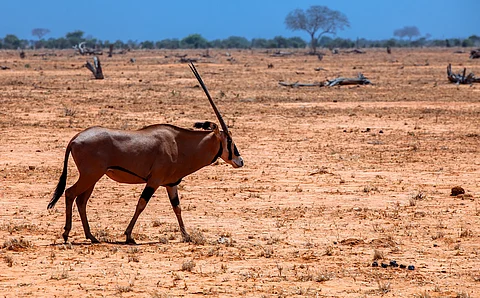

A study in Nature Communications Earth & Environment reveals that human activities are the primary cause of worsening heat waves in Africa.
The rise in greenhouse gas emissions, deforestation, and urbanization are driving more frequent and intense heat events, leading to severe water shortages, crop failures, and health impacts.
The study calls for targeted adaptation strategies to mitigate these effects.
Heat waves across Africa are becoming more frequent, intense, and longer-lasting—and human activities are the main cause, according to a study published recently in the journal Communications Earth & Environment. The sharp rise in greenhouse gas (GHG) emissions, particularly carbon dioxide, is the main driver behind this alarming trend, the study warned.
Human activities—like deforestation, rapid urbanisation, land-use changes and intensive farming—further amplify the greenhouse effect, the study stated, drawing on research from the US, the EU, China, and West Africa
These changes not only increase the chances of extreme heat events but also worsen water shortages, crop failures, heat-related illnesses, energy demands, and economic and health impacts. Led by Vishal Bobde and Kayode Ayegbusi of the University of Illinois, the study highlighted case examples from countries including Nigeria, underscoring Africa’s growing vulnerability to heat extremes.
Based on an extensive analysis of heat wave patterns from 1950 to 2014, the study found that human activities (anthropogenic forcing) have played a major role in driving these trends, though their influence has varied over time. The study concluded this based on analysis of three types of heat waves—daytime, nighttime, and compound—across Africa during the period.
The study found that between 1950 and 1979, temperatures remained mostly stable. This was due to the cooling effect of rising sulphate (SO4) pollution, which increased cloud formation and reflectivity, offsetting GHG-driven warming. As a result, most heat events during this period were caused by natural climate variations, not human activity.
However, the past three decades (1985 to 2014) have seen GHG emissions take over as the dominant force behind longer, hotter, and more frequent heat waves. From 1985 to 2014, falling sulphate pollution and rising GHG emissions led to widespread warming and disrupted weather patterns.
During this time, all heat wave types became more frequent, lasted longer, and grew more intense across most of Africa. On average, each decade saw over 0.15 more heat waves, more than 0.3 additional heat wave days, and a rise in heat wave temperatures of over 0.3°C. According to the study, greenhouse gases were the dominant cause of this warming, responsible for about 70 per cent of the heat wave increase, while natural climate changes accounted for just 30 per cent.
Looking beyond 2014, the researchers analysed newer data up to 2024 too and found that heat waves have continued to intensify in recent years. In fact, the year 2024 was the warmest or second-warmest year on record for Africa, along with devastating floods, droughts and marine heat waves according to the State of Climate in Africa 2024 report.
Throughout February, western Africa was hit by unusually intense heat. Temperatures exceeded 40 °C in some regions, prompting the Ghanaian and Nigerian meteorological services to issue heat warnings.
While heat waves in Africa have been studied before too, this research offers deeper insights for designing effective adaptation strategies the authors claim.
Earlier research has often focused on individual sub-regions, like southern or West Africa, or used fixed seasonal periods for measuring heat waves, such as June to August in the north or December to February in the south. But such definitions fall short for Africa, where the hottest months vary widely across regions—even within the same latitude.
To correct this, the study introduces a novel method: identifying the hottest three consecutive months at each location across Africa, based on long-term temperature records. This grid-specific approach better captures when and where heat waves strike most intensely, particularly in equatorial regions where traditional seasonal analysis often fails. This approach allows to see the actual seasonal peaks in extreme heat—critical information for designing adaptation strategies.
While Africa has contributed negligibly to the changing climate, it stands out disproportionately as the most vulnerable region in the world. So, the study advocates for targeted adaptation and mitigation strategies to reduce the impacts of heat waves on vulnerable communities across Africa.
Strengthening multi-hazard early warning systems, improving heat-risk literacy, and co-developing locally tailored adaptation strategies with vulnerable populations can substantially reduce heat wave exposure and improve preparedness, the study suggested.